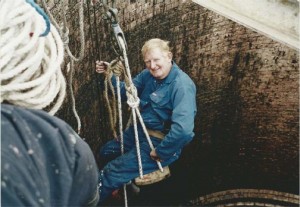
Brian Segar was a seaman in The Royal Navy. While in training school at just seventeen, he was the quickest of 200 boys to climb to the top of the mast on ship, so it really is no surprise that after he left the Navy he became a steeplejack.
When I first met Brian and asked him about working on the chimneys he recited such encyclopaedic detail that I felt as if he must have been reading a maintenance report on the chimneys, but every job Brian worked on was unique and left its own story with him.
“I remember the first time I encountered the power station chimneys at Ringsend – number 1 and number 2 chimneys are 650 foot in height, the diameter is 15 feet at the top and 30 feet at the bottom. Maintenance to these chimneys was carried out by steeplejacks who erected internal rigs and assembly systems with alpha 500 climbers. These are designed to climb 9.5mm wires which were suspended from beams that span the top of the chimneys. This allowed us access to demolish and rebuild sets of lining that were damaged during the running of the chimneys.”
Brian took part in the maintenance of both chimneys since 1991, first of all with Finn Steeplejacks and in later years with J Rainey and Company Steeplejacks. He told me they were built by Tileman from the UK who were well known in England for building refinery chimneys – they were industrial concrete chimney builders. They used a system called slip form which involved a circle shape of shuttering. Poured concrete went into that circle shape, then, when that dried, the circle of shuttering would be moved upwards and more concrete poured in, so the chimney grew from the ground up, one piece of concentric cement on top of another.
Brian is well travelled and showed me a video of him climbing the weather vane in Killarney Cathedral, truly a job for someone who climbed rigging for years. As our conversation comes to an end he jokingly tells me how on occasion, for a few glasses of rum, he would dive from the mast of a ship into the Mediterranean Sea.
By Joan Mitchell



